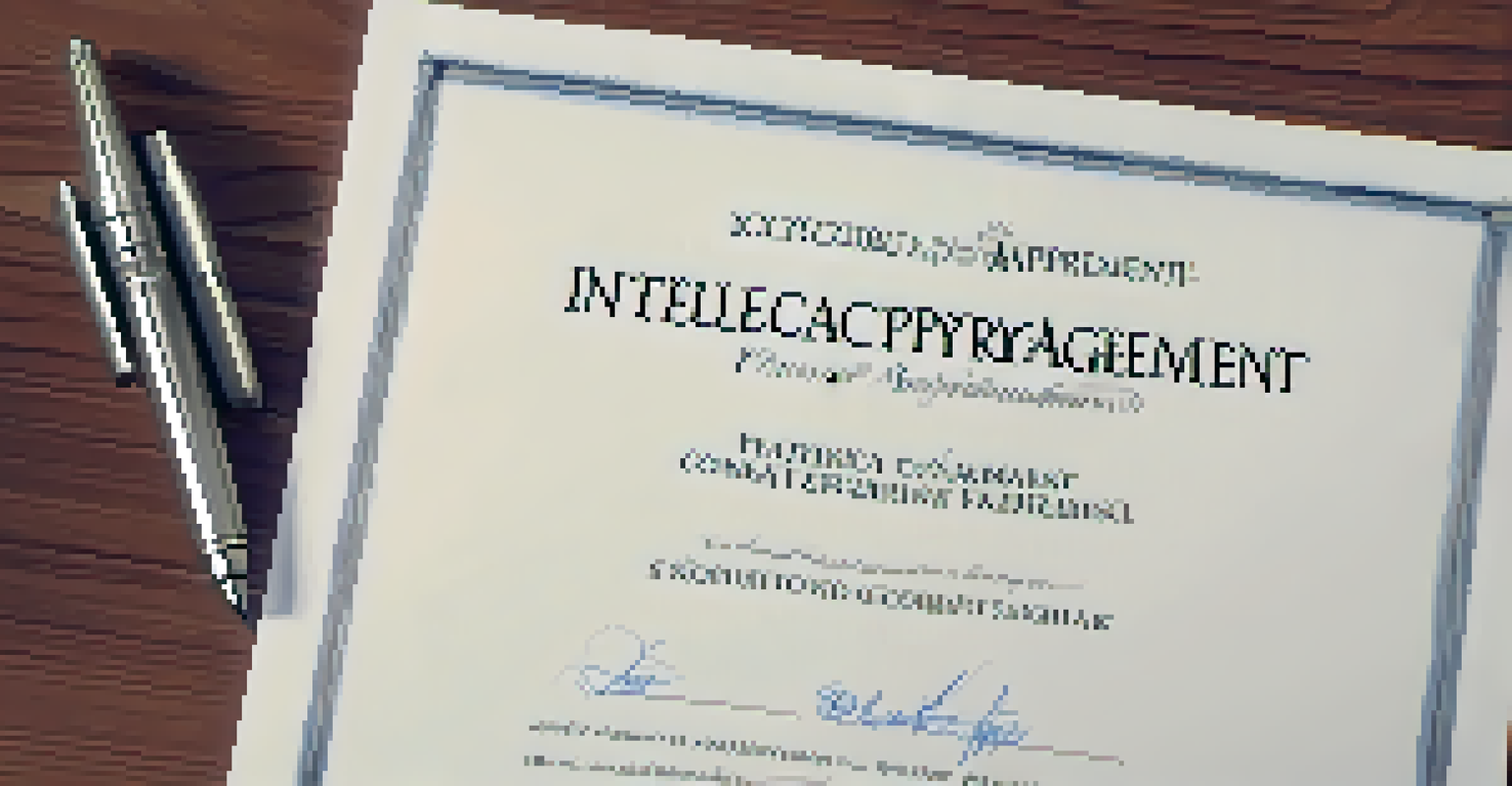Navigating Intellectual Property in EdTech Innovation

Understanding Intellectual Property: The Basics
Intellectual Property (IP) refers to creations of the mind, such as inventions, literary and artistic works, and symbols, names, and images used in commerce. In the EdTech sector, this can include software, educational content, and even curriculum designs. Understanding IP is crucial for safeguarding your innovations and maintaining a competitive edge.
Intellectual property is the oil of the 21st century.
There are several types of IP, including patents, copyrights, trademarks, and trade secrets, each serving a different purpose. For instance, while patents protect inventions, copyrights safeguard original works like educational videos or written material. Knowing the right type of IP to apply for can save you time and resources in the long run.
Navigating IP can feel overwhelming, especially for startups in the fast-evolving EdTech landscape. However, a basic understanding of these concepts can empower you to protect your creations effectively, ensuring that your hard work doesn’t go unrecognized or misappropriated.
The Importance of IP in EdTech Innovation
In the rapidly growing EdTech industry, innovation is key to staying relevant. Intellectual property plays a crucial role in this by protecting your unique ideas and solutions from competitors. By securing IP rights, you not only safeguard your creations but also attract potential investors who see value in your innovation.

Moreover, having a strong IP portfolio can enhance your reputation within the market. It signifies that your company values originality and is committed to fostering an environment of creativity. This can lead to partnerships and collaborations that further propel your innovations.
IP Safeguards EdTech Innovations
Intellectual property protection is essential for safeguarding unique ideas and attracting investors in the EdTech sector.
Ultimately, IP protection can lead to significant financial benefits. When your intellectual assets are well-protected, they can be monetized, whether through licensing agreements, partnerships, or outright sales, providing a vital revenue stream for your EdTech venture.
Common IP Challenges in EdTech
One of the biggest challenges in the EdTech sector is the difficulty of defining what constitutes original work. Given the collaborative nature of education technology, it's common for ideas to overlap, making it hard to establish ownership. This can lead to disputes that may hinder innovation and growth.
Innovation distinguishes between a leader and a follower.
Another challenge is the rapid pace of technological advancement. What is cutting-edge today may become outdated tomorrow, leaving IP owners scrambling to keep up. This constant evolution necessitates a proactive approach to IP management that can feel daunting for many companies.
Additionally, many startups may lack the resources to effectively navigate the complexities of IP law. This can result in unintentional infringements or missed opportunities for protection, underscoring the need for education and support in this area.
Best Practices for Securing IP in EdTech
To effectively protect your intellectual property, it's essential to conduct thorough research. Before launching a new product or service, check existing patents and trademarks to ensure you’re not infringing on someone else's IP. This not only safeguards your company but also fosters a culture of respect for others' innovations.
Engaging with legal professionals who specialize in IP can provide invaluable guidance. They can help you navigate the complexities of the law and ensure that your innovations are adequately protected. Consider consulting an IP attorney to assist with filing patents or trademarks and to develop a comprehensive IP strategy.
Navigating IP Challenges
Startups in EdTech face challenges like defining original work and keeping up with rapid technological advancements that complicate IP management.
Finally, educate your team about the importance of IP. Encourage an internal culture that values innovation and understands the implications of IP theft or misuse. By fostering awareness, you create a proactive environment that prioritizes the protection of your intellectual assets.
Leveraging IP for Competitive Advantage
Once your IP is secured, it can become a valuable asset that sets you apart from competitors. By highlighting your unique offerings, such as proprietary software or exclusive content, you can create a strong brand identity that resonates with educators and learners alike. This differentiation can enhance your market position significantly.
Additionally, consider using your IP as a bargaining chip in partnerships or negotiations. Having protected assets can lead to collaboration opportunities with other organizations, allowing you to combine strengths and drive innovation further. This can also open doors for funding, as investors are often attracted to companies with a solid IP foundation.
Finally, don’t underestimate the power of effective marketing around your IP. Share your success stories and how your innovations have positively impacted educational outcomes. This not only showcases your commitment to quality but also establishes trust and credibility in the EdTech space.
The Role of Collaboration in IP Management
Collaboration is a cornerstone of innovation in EdTech, but it can complicate IP management. When multiple parties are involved, it’s essential to clearly define ownership and usage rights from the outset. Drafting comprehensive agreements that outline IP rights can prevent misunderstandings and disputes later on.
Engaging in open communication with collaborators is key. Regular discussions about contributions and expectations can foster a transparent environment where everyone feels valued. This can lead to more productive partnerships and innovative outcomes.
Collaboration Shapes IP Management
Clear agreements and open communication are vital for managing IP effectively in collaborative EdTech projects.
Finally, consider establishing joint IP ownership agreements when collaborating on projects. This ensures that all parties benefit from the shared innovations and can mitigate potential conflicts over ownership in the future.
Future Trends in EdTech and IP Protection
As technology continues to evolve, so too will the landscape of intellectual property in EdTech. Emerging trends like artificial intelligence and blockchain are reshaping the way we think about IP protection. Companies need to stay informed about these advancements to leverage new opportunities and address potential challenges.
For instance, AI can assist in monitoring IP infringements, making it easier for companies to protect their assets. Conversely, the rise of digital content can blur the lines of copyright, necessitating updated approaches to IP law that reflect contemporary realities.

Looking ahead, proactive IP strategy will be crucial in navigating these trends. By anticipating changes in technology and law, EdTech innovators can position themselves for success while safeguarding their intellectual property.